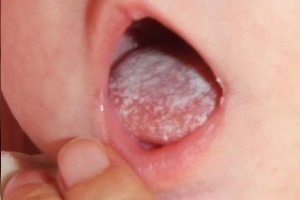 Every mother knows the state when the child starts to be capricious, does not sleep well, refuses milk or porridge. It would seem that there are no apparent reasons for this.
Every mother knows the state when the child starts to be capricious, does not sleep well, refuses milk or porridge. It would seem that there are no apparent reasons for this.
But if you perform a thorough examination of the child, including his oral cavity, you can notice on the mucous and tongue small white sores, swollen gums. These are obvious signs of stomatitis.
Contents of
- Features of stomatitis at tender age
- Provoking factors
- Symptoms depending on the form of the disease and causative agent
- Division by pathogens
- Diagnostic criteria
- Treatment methods
- What does traditional medicine offer?
- Preventive measures
Features of stomatitis at tender age
Stomatitis in newborns and infants is a unifying concept of all problems associated with the oral cavity. Swelling of the gums, white curdled scurf on the tongue, small white sores, inflammatory process can  be called one word "stomatitis".Adult people also often face such a problem, but more often after a few therapeutic procedures restore the mucosa.
be called one word "stomatitis".Adult people also often face such a problem, but more often after a few therapeutic procedures restore the mucosa.
The baby is much more complicated, the baby can not explain what exactly is bothering him, and therefore it is very difficult to diagnose the disease in time, especially the signs of stomatitis resemble the symptoms of angina. And most parents start to treat angina, and stomatitis, meanwhile, gets a more complex form.
Aggravating factors
The occurrence of stomatitis in newborns and small babies can have various causes. First of all, this is the presence of a bacterial, viral or fungal infection. Infection can occur at any time. And the main reason is the drying out of the oral mucosa. Due to lack of saliva, its bactericidal ability is lost. And in this case, there is room for the emergence of various inflammatory processes.
The disease can also provoke mechanical damage to the oral cavity. It can also occur due to careless handling of a metal spoon( which is why lately they prefer to use spoons made of environmentally friendly plastic for babies), and because of a hot food burn.
If microtraumas are formed in the mouth, bacteria that are on poorly washed children's dishes or toys can get into them and cause the development of an inflammatory process.
Often the cause of the disease are viruses that quietly live in the mouth of very loving parents and during a kiss with saliva, the baby can get to.
The variety of different ways of development of various types of disease, according to doctors, have some common causes:
- hereditary predisposition;
- nervous tension, agitation, stress;
- deficiency of vitamins;
- overwork;
- is an allergy.
Symptoms depending on the form of the disease and causative agent
There are several types of stomatitis, each of which will have its own symptoms:
- aphthous;
- catarrhal;
- ulcerative;
- candida;
- herpetic;
- is allergic or contact.
Aphthous stomatitis was named after the word "aphtha".It is a small white colored plaque that protrudes on the mucous surface of the 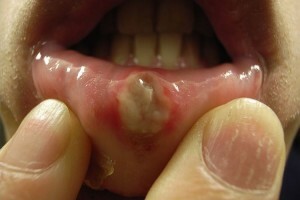 oral cavity. The jug is surrounded by a red ring and covered with a gray bloom. The appearance of this type of disease passes without raising the body temperature.
oral cavity. The jug is surrounded by a red ring and covered with a gray bloom. The appearance of this type of disease passes without raising the body temperature.
Allergies to food, deficiency of B vitamins and folic acid, anemia, viral infection and even stress can be the causes of the aphthous form of the disorder.
The catarrhal form of the disease manifests itself as an intense reddening of the oral cavity. With this type of violation, rashes are very rare. Stomatitis covers the entire surface of the mucosa in the mouth. The patient has fatigue, lethargy, severe headache. The condition is aggravated by an increase in temperature.
Catarrhal stomatitis in infants can occur suddenly, with acute form of the disease occurs quickly, if the onset of a sluggish form, the symptoms are weakly manifested and the whole process can last a very long time.
Ulcerative stomatitis is a problem of very debilitated children. Sometimes aphthous or catarrhal forms become ulcerative. This is the case if the previous species did not receive complete treatment or were later diagnosed. The sores penetrate deep into the mucous membrane, damaging it, almost always bleed and have a yellowish or grayish color.
Division by pathogens
In addition to the nature of the disease, stomatitis is divided into species and pathogens that have affected the mucosa.
Candidiasis is the most common form. A child can get it in the first days of life by contracting from the mother. If, however, during
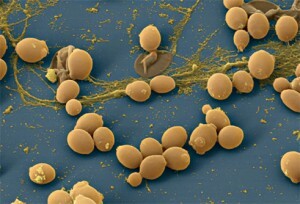
Mushrooms Candida under the microscope
of pregnancy and after childbirth was hit with thrush, then, as a rule, the pathogens of the disease will be transmitted to the child. Therefore, the reason can be poor compliance with hygiene rules. Candidiasis can also be a consequence of prolonged use of antibiotics.
The disease manifests itself in the form of a cheesy plaque on the tongue, the inner surface of the cheeks, gums and even on the lips. At the same time, all these organs have a small swelling and redness.
The causative agents of this type of infringement are the fungi of the Candida group. It is quite resistant to the environment, microorganisms and for a long time can exist on any surface. If candidal stomatitis is diagnosed, it is necessary to disinfect in the house all the items that the baby uses: toys, bottles, nipples, etc., while paying special attention to breast and nipple hygiene.
Herpetic acute stomatitis is the primary form of herpes simplex infection. This form affects children from six months to three years.
The disease begins with a rise in body temperature to 38.5-39 ̊ C. The child becomes sluggish, moody, does not sleep well, but refuses to eat. Plaque-aphthae appear in the mouth, and their number increases every day. Inflammers closely located lymph nodes. There is an unpleasant smell from the mouth.
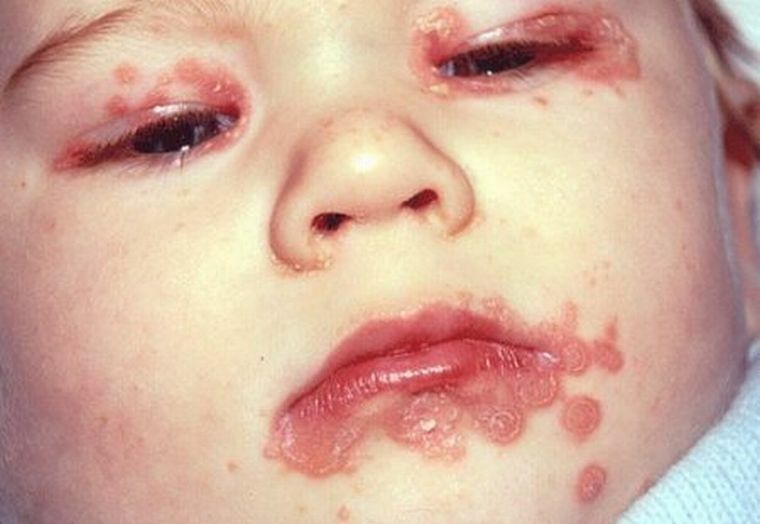
At the infants on the photo blepharitis combined with herpetic stomatitis
Allergic and contact stomatitis are similar in symptomatology. These diseases result from an allergic reaction to various products or some of their components. On the other hand, contact with some chemicals causes characteristic reddening, swelling, combined in a neglected state with bleeding.
General symptoms that are typical for stomatitis in newborns:
- the main symptom are small sores that appear in the baby's mouth, and the wound causes painful sensations when touched, which greatly irritates the baby;
- tongue is covered with white coating, if it is removed with a gauze swab, then bleeding wounds may appear on the tongue;
- the baby refuses the breast, spits out the nipple, as the sucking process causes pain;
- increased body temperature;
- redness and swelling of the gums;
- abundant salivation.
Diagnostic criteria
 Diagnosis of the disease at an early stage of development leads to a rapid recovery. Attentive parents will notice changes in the behavior of their child. Frequent whims, refusal of food should encourage mom to check her mouth.
Diagnosis of the disease at an early stage of development leads to a rapid recovery. Attentive parents will notice changes in the behavior of their child. Frequent whims, refusal of food should encourage mom to check her mouth.
Redness, swelling, minor sores should be the reason to seek medical help as soon as possible. To confirm the hypothesis, the doctor prescribes several tests. This is a blood test and a smear from the oral mucosa to the bac.
Treatment methods
Thanks to an accurate and timely diagnosis of stomatitis in the baby, the doctor prescribes symptomatic treatment.
There are some general principles that parents should adhere to:
- Carefully treat the inflamed oral cavity of the baby with antiseptic means .Such as Chlorhexidine, Miramistin or a decoction of chamomile pharmacies. Treat several times a day. For this, it is necessary to moisten a small
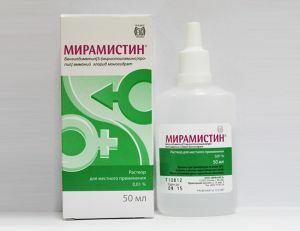 sterile gauze tampon with the proposed tool and very carefully, without rubbing, to treat the surface of the tongue, cheeks, gums, the upper palate.
sterile gauze tampon with the proposed tool and very carefully, without rubbing, to treat the surface of the tongue, cheeks, gums, the upper palate. - Thorough treatment of accessories for feeding .The most effective way is boiling. If some objects can not be boiled, then they should be held in Chlorhexidine for several minutes. It is also necessary to thoroughly treat the breast and nipple of the mother with the antiseptic after each feeding.
- Do not interrupt feeding .In the event that eating is accompanied by a cry of the baby due to painful sensations, it is possible to purchase special anesthetic gels in the pharmacy and apply them before feeding strictly following the instructions. It is important to emphasize that the analgesic should be exactly gel-like, since the use of sprays in infancy is prohibited.
- When is fed, it is necessary to monitor the temperature of the mixture and try to stick to one parameter so as not to cause a thermal burn of the oral cavity, which can cause stomatitis.
- In the room where the baby is, it is important to constantly maintain the necessary microclimate .It consists in air temperature not exceeding 18 ̊ С, and strictly defined humidity of air. To humidify the air, it is good to use special moisturizers.
Treatment of stomatitis in newborns and infants is not an easy task, because of their small age, most drugs are contraindicated.
Means for lowering the temperature and local anesthesia should be used only on the basis of paracetamol. The form of the drug can be chosen individually. This is syrup or suppository. Dosage is used in the calculation of 15 mg per kilogram of the weight of the child. Frequency of admission - 4 times a day.
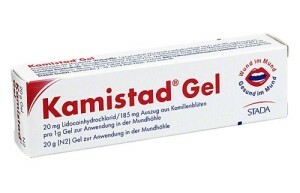 For the anesthesia of affected areas with food, you can offer Kami-Histad or Calgel gels. They are applied directly to the affected areas. To the above antiseptic agents, you can add Lugol, Furacilin, Stomatophyte.
For the anesthesia of affected areas with food, you can offer Kami-Histad or Calgel gels. They are applied directly to the affected areas. To the above antiseptic agents, you can add Lugol, Furacilin, Stomatophyte.
Simultaneously with taking medications, it will not be superfluous to use various vitamin complexes that are appropriate for age, for the concept of immunity.
For the recovery of mucous and regeneration, special ointments, gels or oils, such as Aekol, Solcoseryl, sea buckthorn oil, can be used. These drugs are applied with the help of cotton buds on the affected area of the mucosa.
Depending on the causative agent of the disease, select antibacterial or antiviral drugs.
The disease can go on in a chronic form, if you do not perform a medical procedure, the inflammation of the mucosa can lead to inflammation of the gums, their bleeding, which in the future can lead to tooth loss. Bacterial infection can penetrate the respiratory tract and cause laryngitis.
But the most serious situation is when the infection gets into the blood and spreads throughout the body.
What does folk medicine offer?
It should be remembered: treatment of stomatitis with folk remedies is only an auxiliary measure, which will be in addition to the therapy prescribed by the attending physician.
The best way is to rinse with sugary broths, St. John's wort or cabbage juice. Of course, for a baby, the rinsing method does not quite fit. You can also use a sterile gauze swab for this purpose. But be sure to use broths with caution, so as not to cause allergies.
You can not treat sores with green or hydrogen peroxide, as you can cause burns of mucous membranes.
Often in folk medicine for the treatment of stomatitis use honey, but for babies this product is not acceptable. On the one hand, honey can cause allergy in a child, and on the other hand - in a sweet honey medium bacteria and fungi develop well.
Preventive measures
This insidious disease, having appeared once, it can pursue the child all life. The appearance of the disease in a child closely  is associated with the state of immunity of the newborn and the lack of proper nutrition.
is associated with the state of immunity of the newborn and the lack of proper nutrition.
From an early age, you need to monitor oral hygiene, avoid stressful situations. At the first signs of the disease, consult a doctor.
It is very important that an infant should have his own dishes to avoid getting infection from adults. Children's dishes must be boiled from time to time, and with each washing rinse with boiled water.
You should not allow kisses with outsiders in general, and even more on the lips. At the slightest signs of illness in an adult, it is worth limiting his contact with the baby.
